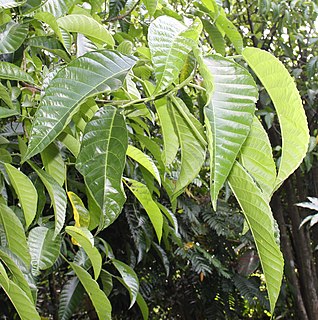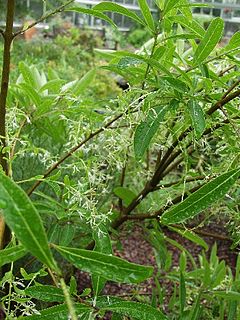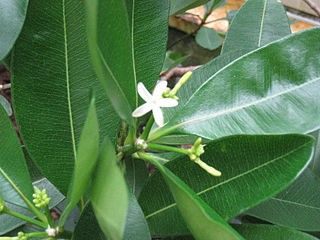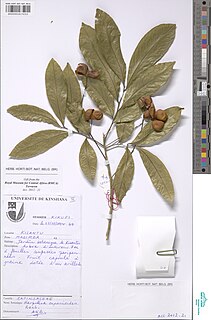
Antidesma is a genus of tropical plant in the family Phyllanthaceae formally described by Linnaeus in 1753. It is native to tropical Africa, S + E + SE Asia, Australia, and various oceanic islands. The greatest diversity occurs in Southeast Asia.

Canarium is a genus of about 100 species of tropical and subtropical trees, in the family Burseraceae. They grow naturally across tropical Africa, south and southeast Asia, Indochina, Malesia, Australia and western Pacific Islands; including from southern Nigeria east to Madagascar, Mauritius, Sri Lanka and India; from Burma, Malaysia and Thailand through the Malay Peninsula and Vietnam to south China, Taiwan and the Philippines; through Borneo, Indonesia, Timor and New Guinea, through to the Solomon Islands, Vanuatu, New Caledonia, Fiji, Samoa, Tonga and Palau.

Drosera peltata, commonly called the shield sundew or pale sundew, is a climbing or scrambling perennial tuberous species in the carnivorous plant genus Drosera. Among the tuberous sundews, D. peltata has the largest distribution, which includes eastern and western Australia, New Zealand, India, and most of Southeast Asia including the Philippines. The specific epithet is Latin for "shield shaped", a reference to the shape of the cauline leaves. It is either a single extremely variable species, or a complex of several closely related species of uncertain taxonomic boundaries. In Australia at least four forms have had or still have specific taxonomic recognition: Drosera peltata subsp. peltata, D. peltata subsp. auriculata, D. foliosa and D. gracilis.

Dysoxylum is a flowering plant genus of trees and shrubs from the mahogany family, Meliaceae.

Jagera is a genus of 4 species of forest trees known to science, constituting part of the plant family Sapindaceae.

Dendrocnide is a genus of approximately 40 species of plants in the nettle family Urticaceae. They have a wide distribution across North East India, Southeast Asia, Australia and the Pacific Islands. In Australia they are commonly known as stinging trees.

Dendrocnide moroides, commonly known in Australia as the stinging tree, stinging bush or gympie-gympie, is a plant in the nettle family Urticaceae found in rainforest areas of Malesia and Australia. It is notorious for its extremely painful and long-lasting sting. The common name gympie-gympie comes from the language of the indigenous Gubbi Gubbi people of south-eastern Queensland.

Chionanthus, common name: fringetrees, is a genus of about 150 species of flowering plants in the family Oleaceae.

Beilschmiedia is a genus of trees and shrubs in family Lauraceae. Most of its species grow in tropical climates, but a few of them are native to temperate regions, and they are widespread in tropical Asia, Africa, Madagascar, Australia, New Zealand, North America, Central America, the Caribbean, and South America. The best-known species to gardeners in temperate areas are B. berteroana and B. miersii because of their frost tolerance. Seeds of B. bancroftii were used as a source of food by Australian Aborigines. Timbers of some species are very valuable.

Streblus brunonianus, known as the whalebone tree, is a small tree in the fig family. Commonly seen in a variety different types of rainforest, particularly by streams.

Dendrocnide photinophylla, the shining-leaved stinging tree, is a rainforest tree of eastern Australia. It occurs from near the Colo River northwest of Sydney to Cooktown in tropical Queensland. A versatile species, it occurs in many different rainforest types. The specific epithet photinophylla translates to shining leaf. The generic name translates to stinging tree.
Tristiropsis acutangula is a tree species in the flowering plant family Sapindaceae. It grows naturally in the Malesian biogeographical region and in northern Australia.

Ochrosia ackeringae is a species of flowering plant in the family Apocynaceae that is found in the Malesian region. The specific epithet honours the collector of one of the syntypes.

Ehretia microphylla, synonym Carmona retusa, also known as the Fukien tea tree or Philippine tea tree, is a species of flowering plant in the borage family, Boraginaceae.

Cycas rumphii, commonly known as queen sago or the queen sago palm, is a dioecious gymnosperm, a species of cycad in the genus Cycas native to Indonesia, New Guinea and Christmas Island. Although palm-like in appearance, it is not a palm.

Claoxylon indicum is a dioecious flowering plant in the spurge family Euphorbiaceae. The Latin specific epithet indicum means "Indian", referring to the locality of collection of the type specimen, which was probably Java, part of the Dutch East Indies at that time.

Pometia pinnata is a large tropical hardwood and fruit tree species, with common names including matoa, taun tree, island lychee, tava, Pacific lychee of the plant family Sapindaceae.
Toona sureni is a species of tree in the mahogany family. It is native to South Asia, Indochina, Malesia, China, and Papua New Guinea. It is commonly known as the suren toon, surian, limpaga, iron redwood or the red cedar. It is also known as the Indonesian mahogany or the Vietnamese mahogany. The species is a valuable timber tree.

Harpullia cupanioides is a plant in the Sapindaceae family found in south east Asia: in the Andaman Islands, Assam, Bangladesh, Borneo, Cambodia, Yunnan, Hainan, Jawa, Laos, the Lesser Sunda Islands, Malaysia, Myanmar, New Guinea, Nicobar Islands, the Philippines, the Solomon Islands, Thailand, and Vietnam.

Palaquium galactoxylum is a species of flowering plant in the family Sapotaceae, endemic to rainforests of northern Australia and New Guinea.
















